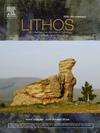Two stages of magmatism at the northern edge of Gondwana (SE Iran): New insights into tectono-magmatic evolution from UPb zircon geochronology
IF 2.9
2区 地球科学
Q2 GEOCHEMISTRY & GEOPHYSICS
引用次数: 0
Abstract
The magmatic and geochemical evolution of the Golgohar granitoids in the southern Sanandaj-Sirjan Zone (SE Iran) were investigated through zircon U![]() Pb ages, Hf isotopic analyses, and whole-rock chemistry, providing insights into their petrogenesis and tectonic context. The geochronological results revealed two distinct stages of magmatism: the late Neoproterozoic-early Cambrian (568.4 ± 7.3–535.9 ± 9 Ma) and the late Carboniferous (311.8 ± 5–305.8 ± 3.9 Ma). The Precambrian rocks are predominantly composed of granite, and the late Carboniferous rocks are primarily monzonite; both sheared, deformed and strongly shuffled together. The bulk-rock chemical characteristics of these rocks overlap to some extent, predominantly displaying peraluminous and calc-alkaline signatures with similar element abundances, though with subtle distinctions. Both rock suites show positive anomalies in Cs, Rb, Pb, U, and Th, and negative anomalies in Ba, Eu, Sr, Nb, and Ta, with the late Carboniferous samples exhibiting relatively greater enrichment in Cs, Ba, Sr, and Eu. The Precambrian rocks are characterized by arc-like affinities, whereas the late Carboniferous samples can be categorized as within-plate rocks. Despite the geochemical similarities, the zircon Hf isotopic compositions reflect different source materials. The Precambrian samples mostly yield negative ƐHf(t) values, with some positive inputs (−6.24 to +17.74) indicating a crustal contribution in their source. In contrast, the late Carboniferous zircon grains show dominant positive ƐHf(t) values (+5.86 to +12.93), suggesting a juvenile mantle source. The obtained isotopic data and geochemical results correspond the Precambrian rocks to the Prototethyan subduction along the northern edge of Gondwana and plausibly attribute the late Carboniferous samples to the early stages of Neotethyan rifting. The observed uniform geochemical characteristics suggest that the late Carboniferous rocks formed from a hybrid parental magma created by mixing the late Carboniferous mantle-derived melts with the Precambrian crustal materials.
Pb ages, Hf isotopic analyses, and whole-rock chemistry, providing insights into their petrogenesis and tectonic context. The geochronological results revealed two distinct stages of magmatism: the late Neoproterozoic-early Cambrian (568.4 ± 7.3–535.9 ± 9 Ma) and the late Carboniferous (311.8 ± 5–305.8 ± 3.9 Ma). The Precambrian rocks are predominantly composed of granite, and the late Carboniferous rocks are primarily monzonite; both sheared, deformed and strongly shuffled together. The bulk-rock chemical characteristics of these rocks overlap to some extent, predominantly displaying peraluminous and calc-alkaline signatures with similar element abundances, though with subtle distinctions. Both rock suites show positive anomalies in Cs, Rb, Pb, U, and Th, and negative anomalies in Ba, Eu, Sr, Nb, and Ta, with the late Carboniferous samples exhibiting relatively greater enrichment in Cs, Ba, Sr, and Eu. The Precambrian rocks are characterized by arc-like affinities, whereas the late Carboniferous samples can be categorized as within-plate rocks. Despite the geochemical similarities, the zircon Hf isotopic compositions reflect different source materials. The Precambrian samples mostly yield negative ƐHf(t) values, with some positive inputs (−6.24 to +17.74) indicating a crustal contribution in their source. In contrast, the late Carboniferous zircon grains show dominant positive ƐHf(t) values (+5.86 to +12.93), suggesting a juvenile mantle source. The obtained isotopic data and geochemical results correspond the Precambrian rocks to the Prototethyan subduction along the northern edge of Gondwana and plausibly attribute the late Carboniferous samples to the early stages of Neotethyan rifting. The observed uniform geochemical characteristics suggest that the late Carboniferous rocks formed from a hybrid parental magma created by mixing the late Carboniferous mantle-derived melts with the Precambrian crustal materials.
冈瓦纳北缘(伊朗东南部)岩浆活动的两个阶段:UPb锆石年代学对构造岩浆演化的新认识
通过锆石UPb年龄、Hf同位素分析和全岩化学分析,研究了伊朗南部sanandaji - sirjan地区各尔戈哈尔花岗岩类的岩浆和地球化学演化,为其岩石成因和构造背景提供了新的认识。地质年代学结果显示岩浆活动分为新元古代晚期—早寒武世(568.4±7.3 ~ 535.9±9 Ma)和晚石炭世(311.8±5 ~ 305.8±3.9 Ma)两个阶段。前寒武纪岩石以花岗岩为主,晚石炭世以二长岩为主;两者都被剪断了,变形了,紧紧地挤在一起。这些岩石的体岩化学特征有一定的重叠,主要表现为过铝质和钙碱性特征,元素丰度相似,但差异不大。两组岩石均表现出Cs、Rb、Pb、U、Th的正异常,Ba、Eu、Sr、Nb、Ta的负异常,其中晚石炭世样品中Cs、Ba、Sr、Eu的富集程度较高。前寒武纪岩石以弧状亲和为特征,而晚石炭世样品可归类为板内岩石。尽管地球化学特征相似,但锆石Hf同位素组成反映了不同的物质来源。前寒武纪样品大多产生负ƐHf(t)值,一些正输入值(- 6.24 ~ +17.74)表明它们的来源有地壳贡献。晚石炭世锆石颗粒以正ƐHf(t)值为主(+5.86 ~ +12.93),表明其地幔源为幼年期。所获得的同位素数据和地球化学结果将前寒武纪岩石与冈瓦纳北缘的原特提斯俯冲相对应,并合理地将晚石炭世样品归因于新特提斯裂陷的早期阶段。地球化学特征一致表明,晚石炭世岩石是由晚石炭世幔源熔体与前寒武纪地壳物质混合形成的混合母岩浆形成的。
本文章由计算机程序翻译,如有差异,请以英文原文为准。
求助全文
约1分钟内获得全文
求助全文
来源期刊

Lithos
地学-地球化学与地球物理
CiteScore
6.80
自引率
11.40%
发文量
286
审稿时长
3.5 months
期刊介绍:
Lithos publishes original research papers on the petrology, geochemistry and petrogenesis of igneous and metamorphic rocks. Papers on mineralogy/mineral physics related to petrology and petrogenetic problems are also welcomed.
 求助内容:
求助内容: 应助结果提醒方式:
应助结果提醒方式:


